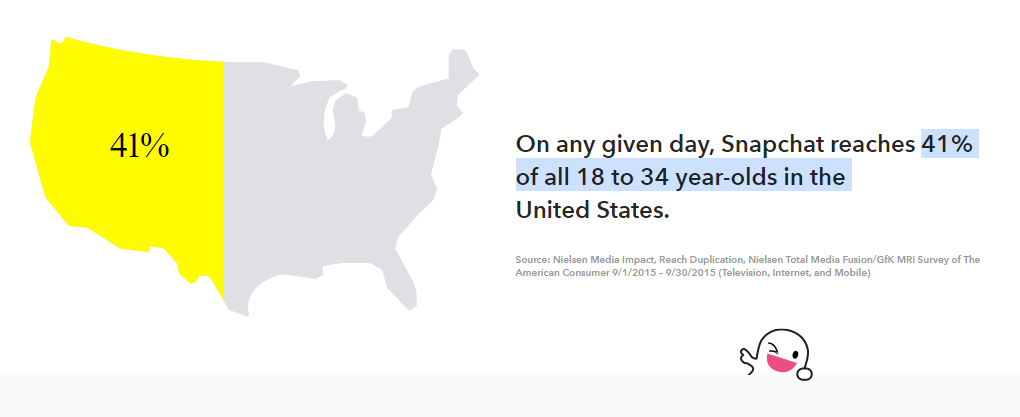

In a quote that’s been referenced many times since, Snapchat CEO Evan Spiegel, during an interview at last year’s Cannes Lions Festival, said that Snapchat “really care[s] about not being creepy” in regards to the possible introduction of more in-depth – but possibly more intrusive – ad options.
The statement triggered warning bells in the minds of advertisers who’d been waiting for the platform to introduce more advanced ad targeting and analytics – Snapchat, of course, has a significant hold on the all-important Millennial market, with more than 150 million daily active users, and daily reach (according to Nielsen) to 41% of all 18 to 34 year-olds in the US.
But Snapchat has since shown that that approach may not be sustainable – or, at least, not conducive to ongoing growth. In the last three months alone, Snapchat’s introduced a range of new options and features to help marketers get more out of the platform, including the launch of their ad API, the addition of Memories, improved discovery options and a new custom Geofilters tool to simplify the creation process. In addition, there’s also the reported expansion of their advanced behavioural targeting tools and the development of image-recognition triggered ads in the works, all of which, in one way or another, offer new commercial opportunities and benefits.
And while none of those measures over-step Spiegel’s aforementioned “creepy” line in the sand, Snapchat’s latest ad options are starting to move much closer to its edges.
The Wall Street Journal has this week reported that Snapchat will soon introduce three new ad targeting options – they are:
- Snap Audience Match – Much like Facebook’s custom audience options, Snapchat will soon enable advertisers to upload a list of customer e-mail addresses and/or mobile app IDs in order to match that data with Snapchat’s own information for enhanced ad targeting. So, for instance, if you wanted to reach your existing customers on Snapchat, you could upload your e-mail list and Snapchat would be able to match that data to e-mails it has listed in its system, which you could then use to reach those users with ads.
- Snapchat Lifestyle Categories – This option will enable advertisers to target users interested in certain types of content, as signified by their activity in the app (i.e. if they regularly check out ESPN’s Discover channel, you could reach them with sports related content)
- Lookalikes – Snapchat’s version of Lookalike Audiences – using the same process as Snap Audience Match, once you’ve uploaded your audience data, Snapchat will be able to use those matched users as templates and create a similar audience, based on related characteristics and behaviors.
All user data will be anonymized, and Snapchat’s going to efforts to ensure no personally identifiable data is made available when executing ad campaigns. But the new measures do show that Snapchat is working to provide additional options for advertisers, and that they won’t necessarily be confined by past process or stances when seeking to help marketers make the most of their on-platform opportunities.
Of course, Snapchat already offers a level of ad targeting – brands are able to hone their ads based on their desired audience’s age, gender, location, what mobile device or operating system they’re using, who their wireless carrier is and which Discover channels or Live Stories they’re regularly consuming. But as noted by Marketing Land, these options offer far more simplistic targeting compared to these new tools.
A rundown of Snapchat’s ad options (via Laura Shephard)
And really, if Snapchat’s ever going to compete with the bigger players, they need to expand their ad options. The company’s currently valued at around $20 billion, which is a huge price tag to live up to. Snapchat’s also facing increased competition from Instagram/Facebook, which could slow audience growth, and even reduce their use rates, particularly if Instagram Stories gains significant momentum.
As such, the time is now for Snapchat to start sweetening the deal for advertisers, and with a possible IPO on the cards, you can expect Snapchat to be bringing out all their big guns in the next few months.
That’s likely good news for advertisers (more, and better, ad options on the massively popular platform), but it might not be as great for users. But then again, Snapchat’s done a great job of putting the user experience first so far, there’s nothing (yet) to indicate that they’ve lost their grip on this key element.
[Source:- Socialmediatoday]

